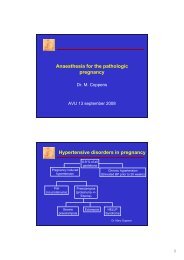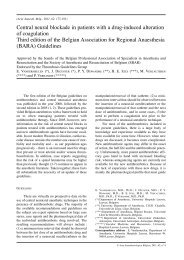Combined spinal epidural analgesia for labor and delivery
Combined spinal epidural analgesia for labor and delivery
Combined spinal epidural analgesia for labor and delivery
You also want an ePaper? Increase the reach of your titles
YUMPU automatically turns print PDFs into web optimized ePapers that Google loves.
116 M. VAN DE VELDE<br />
breakthrough pain. However, several authors initiate<br />
an <strong>epidural</strong> infusion immediately after the initial<br />
<strong>spinal</strong> dose (55). With low volume, low dose techniques,<br />
the risk of total <strong>spinal</strong> anesthesia or toxic<br />
side effects is minimal. These doses cannot produce<br />
systemic toxicity or total <strong>spinal</strong> anesthesia even<br />
when direct intravascular or intrathecal injection<br />
occurs. However, if a continuous <strong>epidural</strong> infusion<br />
or patient controlled <strong>epidural</strong> <strong>analgesia</strong> does not<br />
produce adequate <strong>analgesia</strong>, one must consider an<br />
intravascular position of the catheter.<br />
INTRATHECAL DRUG COMBINATIONS<br />
Local anesthetics<br />
Currently, the most frequently used local anesthetic<br />
agent <strong>for</strong> intrathecal <strong>labor</strong> <strong>analgesia</strong> is bupivacaine,<br />
usually in combination with opioids.<br />
Levobupivacaine <strong>and</strong> ropivacaine have also been<br />
used successfully. LIM et al. compared 2.5 mg bupivacaine<br />
with 2.5 mg ropivacaine <strong>and</strong> 2.5 mg levobupivacaine<br />
(89). Bupivacaine produced the<br />
longest <strong>analgesia</strong> but the highest incidence of motor<br />
block. These results were not confirmed by SAH et<br />
al. who did not find a difference between levobupivacaine<br />
<strong>and</strong> bupivacaine(144). Camorcia <strong>and</strong> coworkers<br />
described the minimum local analgesic<br />
doses of all three local anesthetics <strong>and</strong> suggested a<br />
potency hierarchy of <strong>spinal</strong> bupivacaine > levobupivacaine<br />
> ropivacaine (21). WHITTY et al. described<br />
the ED95 of <strong>spinal</strong> bupivacaine combined with fentanyl<br />
(170). VAN DE VELDE et al. were the first to<br />
construct the full dose response relationship of<br />
<strong>spinal</strong> ropivacaine, levobupivacaine <strong>and</strong> bupivacaine<br />
combined with opioids <strong>for</strong> <strong>labor</strong> <strong>analgesia</strong>.<br />
Contrary to CAMORCIA et al., these investigators<br />
noted that bupivacaine was significantly more<br />
potent then both other local anesthetics <strong>and</strong> that<br />
ropivacaine <strong>and</strong> levobupivacaine were of similar<br />
potency (158).<br />
Opioids<br />
Plain intrathecal opioids are efficient at producing<br />
labour <strong>analgesia</strong>. PALMER et al. established<br />
that 25 µg fentanyl was the optimal intrathecal<br />
dose (121). Increasing the dose above 25 µg did not<br />
improve the duration or quality of <strong>analgesia</strong>, but<br />
increased the incidence of side effects. For sufentanil,<br />
an ED 95 of 8.9 µg was established (70).<br />
However, certainly in Europe, most anaesthesiologist<br />
prefer the intrathecal combination of local<br />
anaesthetics <strong>and</strong> opioids. Adding opioids to the<br />
<strong>spinal</strong> mixture reduces the ED 50 of the local anaesthetic<br />
agent <strong>and</strong> dose-dependently prolongs the<br />
duration of the initial <strong>spinal</strong> <strong>analgesia</strong> (154).<br />
There<strong>for</strong>e, most authors recommend a local anesthetic<br />
/ opioid combination in this indication. WONG<br />
et al. showed that 15 µg fentanyl added to the local<br />
anesthetic/opioid mixture was the optimal dose in<br />
terms of efficacy <strong>and</strong> side-effects (172).<br />
Patients may react very differently to intra -<br />
thecal opioids. LANDAU et al. demonstrated that<br />
mu-opioid receptor genetic variants influence the<br />
dose required to produce effective <strong>analgesia</strong> (85)<br />
(already described above). Respiratory depression<br />
following intrathecal opioids has been described.<br />
This occurred usually in small patients receiving<br />
high doses of opioids following initial parenteral<br />
opioid <strong>analgesia</strong>. Respiratory depression occurred<br />
within 30 minutes from injection. Vigilance following<br />
the intrathecal injection of opioids is there<strong>for</strong>e<br />
required. During labour <strong>analgesia</strong>, intrathecal opioids<br />
have been associated with new onset foetal<br />
heart rate changes (28, 162). Usually these changes<br />
were related to uterine hyperactivity <strong>and</strong> not maternal<br />
hypotension. Several authors postulated that an<br />
imbalance between maternal cathecholamines<br />
following rapid <strong>spinal</strong> <strong>analgesia</strong> produces uterine<br />
hypertonicity. It remains unclear why this only<br />
occurs following high dose intrathecal opioids <strong>and</strong><br />
not following the combination of lower doses of<br />
opioids <strong>and</strong> local anaesthetics (162).<br />
Clonidine<br />
CHIARI et al. studied the use of pure <strong>spinal</strong> clonidine<br />
<strong>for</strong> labour <strong>analgesia</strong> (27). This seems not feasible<br />
since doses producing adequate <strong>analgesia</strong> also<br />
induce unacceptable side effects such as hypotension.<br />
Adding lower doses of clonidine (15-45 µg) to<br />
<strong>spinal</strong> analgesics does improve the duration <strong>and</strong><br />
quality of the initial <strong>spinal</strong> <strong>analgesia</strong> (9, 95, 96,<br />
118). However, especially when clonidine is combined<br />
with local anaesthetic agents, significant <strong>and</strong><br />
prolonged hypotension is likely to occur (9, 96,<br />
118, 125).<br />
Epinephrine<br />
Epidurally administered epinephrine significantly<br />
reduces the MLAC of bupivacaine in labouring<br />
patients <strong>and</strong> improves the quality of <strong>analgesia</strong><br />
(130). Also <strong>for</strong> <strong>spinal</strong> use, epinephrine, combined<br />
with local anaesthetics <strong>and</strong> opioids, has been<br />
evaluated in a wide range of doses from 2.25-<br />
© Acta Anæsthesiologica Belgica, 2009, 60, n° 2
















